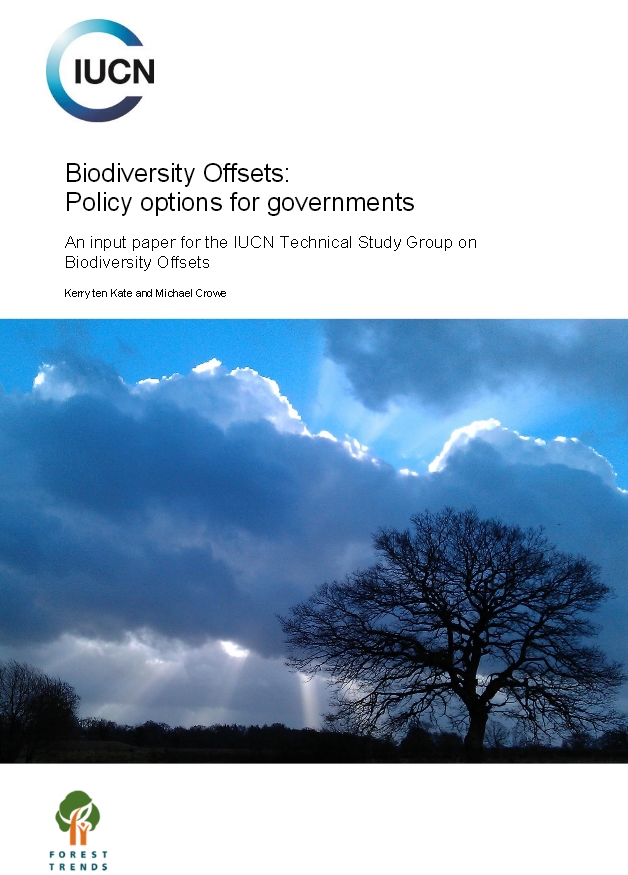 Recently, the IUCN Technical Study Group on Biodiversity Offsets has published some new resources (see also my previous post: Biodiversity Offsets Technical Study Paper). Thanks to Patrick at the BBOP Secretariat for sharing this useful information
Recently, the IUCN Technical Study Group on Biodiversity Offsets has published some new resources (see also my previous post: Biodiversity Offsets Technical Study Paper). Thanks to Patrick at the BBOP Secretariat for sharing this useful information
The present report on biodiversity offsets policy options for governments was written by Kerry ten Kate, Director of the Biodiversity Initiative and of BBOP at Forest Trends, and Michael Crowe, an independent consultant in Victoria, Australia.
The purpose of this paper is to contribute to the consideration of policy options by the IUCN Technical Study Group on biodiversity offsets and the subsequent Working Group, and to provide information more broadly to governments and their advisors. It is intended as a basic introduction to policy on No Net Loss (NNL) or a Net Gain of (NG) of biodiversity, and biodiversity offsets. Discussions of technical issues are explored in more depth in the companion piece (Pilgrim and Ekstrom, 2014). This paper reviews current information, but evidence is lacking as to the extent to which NNL/NG and offset policies are achieving their goals or contributing to better biodiversity outcomes in the jurisdictions where they exist. Bearing in mind these limitations, this paper aims to identify policy options at a general level in the anticipation of subsequent discussion and more evidence
You can access the paper online (in the BBOP Library section) or find the pdf following: Biodiversity offsets_policy options for governments
Find below also the key messages of the paper as formulated by the authors.
Key messages
Governments, companies, banks and civil society are placing more emphasis on the rigorous application of the mitigation hierarchy to avoid, minimize and compensate for projects’ impacts on biodiversity. The mitigation hierarchy is a sequence of steps, starting with avoidance of impacts, minimization of inevitable impacts, on-site restoration and finally biodiversity offsets to achieve No Net Loss (NNL)or a Net Gain (NG) in biodiversity.
Biodiversity offsets are measurable conservation outcomes resulting from actions designed to compensate for significant residual adverse biodiversity impacts arising from project development after appropriate prevention and mitigation measures have been taken. The goal of biodiversity offsets is to achieve no net loss and preferably a net gain of biodiversity on the ground with respect to species composition, habitat structure, ecosystem function and people’s use and cultural values associated with biodiversity.
There are risks and opportunities associated with policies for NNL/NG and the use of biodiversity offsets, and indeed policies have not always achieved their goals nor been clear as to what is understood by NNL/NG and what is the baseline. The principal opportunities are more and better conservation, improved land-use planning, livelihood and job opportunities. The main risks are the use of unrealistic mitigation commitments to allow inappropriate projects to proceed, and failure to achieve NNL/NG as a result of unclear and inadequate rules and methodologies and the lack of enforcement.
Thirty-nine countries have existing laws or policies on NNL/NG, biodiversity offsets or compensation and 22 countries (some of which already have measures in place) are developing them. In addition to public policy, a major driver for No Net Loss and a Net Gain of biodiversity in recent years has been the requirement for NNL/NG within the loan conditions for project finance and safeguards policies of at least 80 financial institutions.
Principles and standards on biodiversity offsets are available. Core concepts include: the principles that underpin NNL/NG; the statement of policy itself, whether this is mandatory or voluntary and how it is established in law and guidance; the scope and limits of the policy; the exchange rules governing which residual impacts can be offset by what type of gains; the metrics for measuring loss and gain; land-use and landscape level planning and the location of mitigation measures (especially areas to be avoided and areas suitable for offset activities); identification of the set of activities which can deliver the secure and additional long-term gains needed to offset residual impacts; clarification of which organizations can undertake the offsetting activities and the standards by which they should abide; underlying data and capacity needs; monitoring and enforcement of commitments on avoidance, minimization, restoration and offsetting; and the governance of the system for delivering NNL/NG.
International experience suggests that NNL/NG measures succeed when: measures are in place to improve the application of the mitigation hierarchy, and not simply to plan offsets (the last step); clear, consistent guidance is available, for certainty and to avoid delays; there are clear roles for national, state and local government and good coordination between government departments; performance monitoring and enforcement is ensured through good governance and adequate budgetary provision; clear principles and standards are in place; legal and financial instruments needed to secure long-term implementation are available; proportionate approaches are planned, with more streamlined procedures and simpler baseline studies and metrics for less significant impacts on biodiversity, and full assessments and metrics for more significant impacts; there is a realistic roadmap to develop the NNL/NG system and improve it over a few years; preparation for implementation (including supply) takes place during the policy development phase; good baseline data, mapping and landscape level planning are available; methods that don’t deliver NNL/NG (e.g.poor metrics) are avoided; several options for implementation are possible, provided the same standards are met; perverse incentives are removed; and assistance is offered to parties such as developers and offset providers who need to find each other.
Recommended first steps for governments interested in exploring NNL/NG policy options include: fact-finding and gap analysis on the existing policy framework, the availability of biodiversity data and maps, and the socioeconomic costs and benefits associated with introducing NNL/NG policy; and pilot projects. This can lead to integrating biodiversity offsets with land-use planning at the national or regional levels, identifying, analysing and evaluating policy options, formulating policy and designing NNL/NG systems, and implementing, monitoring and reviewing policy.
To complement this work by individual governments, it would be helpful for research to provide a more in-depth and critically rigorous comparative analysis of international experience with mitigation measures, offering evidence on whether they have achieved their policy objectives, such as NNL/NG.

Pingback: Technical conditions for positive outcomes from biodiversity offsets. An input paper for the IUCN Technical Study Group on Biodiversity Offsets - Biodiversity Offsets Blog
Pingback: Newsletter of the Business and Biodiversity Offset Programme, May 2015 - Biodiversity Offsets Blog